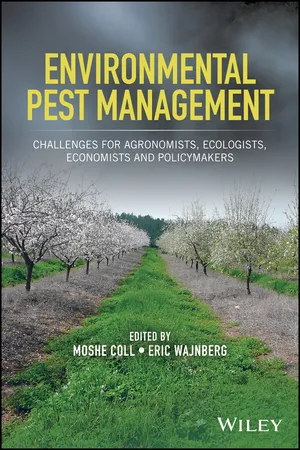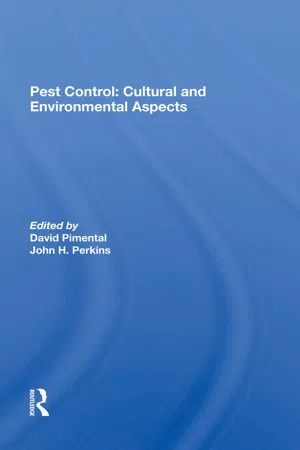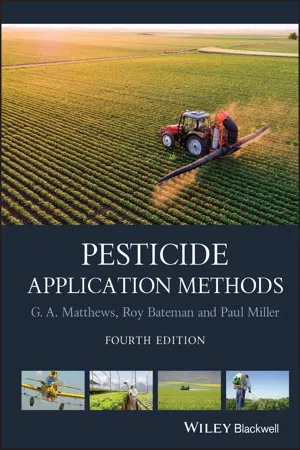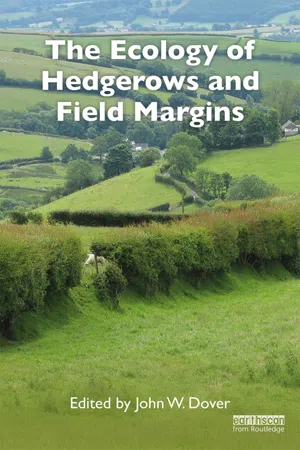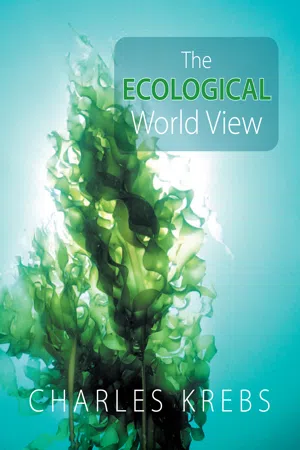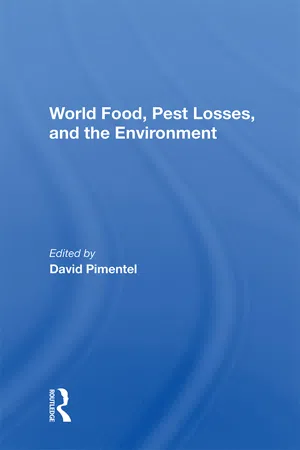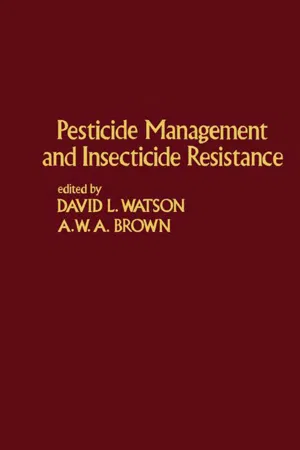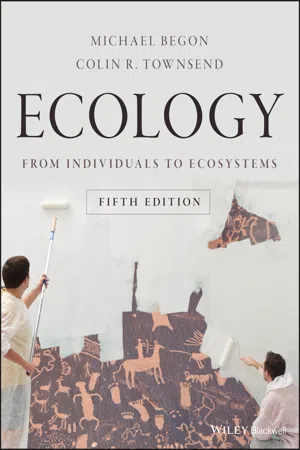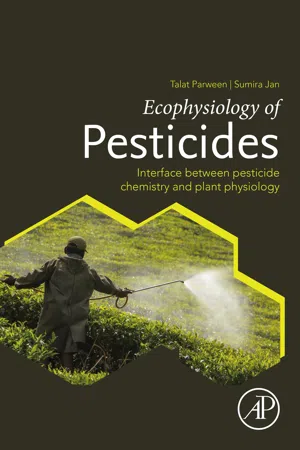Geography
Pesticide Control
Pesticide control refers to the management and regulation of pesticides to minimize their negative impact on the environment, human health, and non-target organisms. This involves measures such as monitoring pesticide use, promoting alternative pest management strategies, and enforcing laws and regulations to ensure safe and responsible pesticide application.
Written by Perlego with AI-assistance
Related key terms
Related key terms
1 of 4
Related key terms
1 of 3
12 Key excerpts on "Pesticide Control"
- eBook - ePub
Environmental Pest Management
Challenges for Agronomists, Ecologists, Economists and Policymakers
- Moshe Coll, Eric Wajnberg, Moshe Coll, Eric Wajnberg(Authors)
- 2017(Publication Date)
- Wiley(Publisher)
An ecosystem‐based strategy that focuses on long‐term prevention of pests or their damage through a combination of techniques such as biological control, habitat manipulation, modification of cultural practices and use of resistance varieties. Pesticides are used only after monitoring indicates they are needed according to established guidelines, and treatments are made with the goal of removing only target organisms. Pest control materials are selected and applied in a manner that minimizes risks to human health, beneficial and non‐target organisms and the environment. University of California (1997) 1998 A decision support system for the selection and use of pest control tactics, singly or harmoniously co‐ordinated into a management strategy, based on cost/benefit analyses that take into account the interests of and impacts on producers, society and the environment. Kogan (1998) 2000 An approach to the management of pests in public facilities that combines biological, cultural, physical and chemical tools in a way that minimizes economic, health and environmental risks. Children’s Health Act (2000) 2002 A broad ecological approach to pest management utilizing a variety of pest control techniques targeting the entire complex of a crop ecosystem. This approach promises to ensure high‐quality agricultural production in a sustainable, environmentally safe and economically sound manner. Bajwa and Kogan (2002) 2009 The rational application of a combination of biological, biotechnical, chemical, cultural or plant‐breeding measures, whereby the use of plant protection products is limited to the strict minimum necessary to maintain the pest population at levels below those causing economically unacceptable damage or loss. European Union, Directive 91/414/EEC (2009) 2013 A science‐based, decision‐making process that identifies and reduces risks from pests and pest management‐related strategies. IPM co‐ordinates the use of pest biology, environmental information and available technology to prevent unacceptable levels of pest damage by the most economical means, while minimizing risk to people, property, resources and the environment. IPM provides an effective strategy for managing pests in all arenas from developed agricultural, residential and public lands to natural and wilderness areas. IPM provides an effective, all‐encompassing, low‐risk approach to protect resources and people from pests. - eBook - ePub
- David Pimentel, John H. Perkins(Authors)
- 2019(Publication Date)
- CRC Press(Publisher)
Much of the research needed as a foundation is basic biological research. Pest management means the maintenance of pest populations at levels that are greater than zero, but below levels where unacceptable economic damage to production exists. This requires more knowledge than we currently have about the pest-enemy-host relationships. Most of this research will become the responsibility of the public sector.Chemicals are most effective in quickly reducing pest populations where explosions occur. Individual farmers will continue to need tools such as these to deal with the inability to fine tune an agro-ecosystem everywhere all of the time. The private sector currently has the responsibility for the development of chemicals that are compatible with the various biological and cultural methods that are a part of the integrated approach, whether this responsibility can be fulfilled remains to be seen.Implications for the System
The purpose of this paper was to describe the changes in agriculture and agricultural pest control in response to its economic milieu and to provide insights needed to improve pest control to meet social objectives. These social objectives continue to be: (a) an economically viable agriculture consisting of a large number of small units, (b) a minimization of the labor and other resources devoted to food and fiber production, (c) ample nutritious food which can be purchased with the incomes of consumers and (d) an environment that is a safe and aesthetically pleasing place in which to live. These are challenging objectives.In order to meet them, changes in the institutional framework will be needed. In order to deal with the very real pest problems that exist, new ways will need to be found to maintain the productivity of agriculture.It has been argued here that due to the imperfections of markets, atomistic competition in production agriculture will not produce a socially acceptable level or kind of pest control. The implication is that some method must be found to deal with these market imperfections. The improvements must adjust for the external effects of the use of chemical pesticides and adjust for short-term planning horizons inherent in the decision framework where pest control decisions are made. - eBook - ePub
- Graham Matthews, Roy Bateman, Paul Miller(Authors)
- 2014(Publication Date)
- Wiley-Blackwell(Publisher)
Chapter 1Chemical control in integrated pest management
Introduction
The human population continues to grow, especially in Asia and Africa, and the demand for food and other agricultural produce will continue to increase so it is not surprising that the market for pesticides continues to grow, despite innovative developments of genetically modified (GM) crops (Figure 1.1 ). In Europe, changes in legislation have significantly reduced the number of pesticides that can be marketed and their use must now form part of the EU Thematic Strategy on Pesticides (Stark, 2012). The restrictions have been in response to public perception of the risks associated with pesticide use in terms of residues in food and adverse effects on the environment. The perception is based erroneously on three false premises (van Emden and Peakall, 1996): that good crops were obtained in an ideal prepesticide era, that chemicals like pesticides never occur in nature, and that these unnatural pesticides are causing an increase in cancer. In practice, plants contain many chemicals which are highly toxic. For example, cyanide in cassava has to be removed by careful food preparation.Without modern technology, including the use of pesticides, tripling world crop yields between 1960 and 1992, an additional 25–30 million square kilometres of additional land would have had to be cultivated with low-yield crops to feed the increased human population (Avery, 1997). Clearly, the use of pesticides plays an important role in optimising yields. Modern technology is changing and many pesticides, such as the persistent organochlorine insecticides, are no longer registered for use as newer, more active or selective chemicals take their place. Many chemicals are also being lost as companies are withdrawing support for them due to the cost of providing the additional data now required for registration, especially in Europe. At the same time, the agrochemical industry has invested in biotechnology and seed companies to exploit use of transgenic crops. The total area of transgenic crops has increased in 16 years to over 160 million hectares by 2011, involving over 16 million farmers in 29 countries (James, 2011) (Figure 1.2 - eBook - ePub
Pesticide Interactions in Crop Production
Beneficial and Deleterious Effects
- J. Altman(Author)
- 2018(Publication Date)
- CRC Press(Publisher)
3 for use of a pest control practice (or any management practice) are (1) technically effective, (2) economically feasible, (3) socially acceptable, and (4) politically practical. The emphasis of this chapter is on agronomics and economics, but the external factors of social and political acceptance of pest control practices must be considered when a pest control system is evaluated for usefulness. Societal interest in environmental consequences of pesticide use and government regulation of use and registration of agricultural chemicals are powerful factors when growers choose pest control practices.Beyond society and governmental constraints, pesticide use is determined by a grower's perception of the pest problem and by availability of control measures. Growers are motivated to use pesticides (as well as other practices) by many factors, including- Economics — Most growers are generally knowledgeable about the cost and benefits of pesticide use.4 Growers also consider the long-term effects of a management practice such as weed control that will influence weed populations in subsequent crops.
- Tradition — Practices which were used in the past, have worked in the past, and are considered a 'community norm'. This perception is balanced by grower independence and intellect.
- Insurance (risk aversion ) — Avoiding potential losses by preventative treatment.5 '6 A desire for a sustained or uniform crop yield also motivates pesticide insurance applications.
- Convenience — Other management practices may be replaced by pesticide application (e.g., burn-down herbicide replacing tillage).
- Environmental impact — Growers are concerned about the impact their farming practices have on the environment. They consume the food and water that comes from their land and are generally aware of public opinion of their practices.
- Benefit duration
- eBook - ePub
- John W. Dover, John W. Dover(Authors)
- 2019(Publication Date)
- Routledge(Publisher)
Safeguarding field margins and hedgerows within agricultural landscapes is essential if we are to enhance the nature conservation value of agricultural landscapes. Thus, the risk of contamination of these important semi-natural habitats with harmful pesticides is a matter with significant ecological and economic implications. Understanding the distribution of pesticides in the environment and their potential effects on biological communities is crucial to properly assess current agricultural management and schemes aiming to boost biodiversity in farmland.Exposure of flora and fauna of hedgerows and field margins to agricultural pesticides
The environmental fate of agricultural pesticides is related to their physico-chemical properties, method and rate of application, abiotic and biotic characteristics of the environment, and meteorological conditions (Graham-Bryce 1981). When a pesticide is applied to a crop or soil, it enters a dynamic ecosystem, where it can move from one part of the system to another (e.g. uptake by plants from soil), degrade in situ, or move out of the system into other systems (Navarro et al. 2007). Pesticides degrading completely and leaving no toxic metabolites become harmless, whereas those that move to other systems or persist have more potential to do environmental damage (Goulson 2013). Though highly variable, a considerable fraction of the initial amount of pesticide applied to crops is dispersed into the environment via air drift, leaching, and runoff, contaminating surrounding soils, surface water, and groundwater (Barbash & Resek 1996; Bonmatin et al. 2015) and thus providing multiple routes for chronic (and sometimes acute) exposure of non-target flora and fauna.Routes of exposure for non-target flora
There is clear evidence that plants in agricultural environments and neighbouring areas are frequently contaminated with variable levels of pesticides and their metabolites (David et al. 2016; Long & Krupke 2016). The use of mechanical sprayers, one of the most frequent methods for pesticide application in conventional agriculture (Herzfeld & Sargent 2011), can lead to hedgerow and field margin contamination via spray drift during application (Otto et al. 2009). Translocation of pesticide droplets from the intended area of application to non-target areas during spraying, as a result of air movement, is considered to be the most important route of contamination of terrestrial off-crop habitats (Candolfi et al. 2001). Pesticide spray drift deposits have been extensively detected in the vegetation of field margins and hedgerows (Longley et al. 1997) at levels reaching harmful doses for the non-target flora inhabiting the field boundaries (Freemark & Boutin 1994). Moreover, non-crop habitats adjacent to fields may be sprayed with pesticides intentionally in attempts to eliminate potential reservoirs of unwanted plant species or their associated crop pests and pathogens (Boatman 1989). - eBook - ePub
- Charles Krebs(Author)
- 2008(Publication Date)
- CSIRO PUBLISHING(Publisher)
control damage and is not used in the engineering sense of regulating the pest population around some equilibrium density. One of the obvious ways of controlling damage is to reduce the average abundance of the pest species, but there are other ways of reducing damage by pests without affecting abundance (such as using insect repellents).Economic Pests and Ecological Pests
In the field of pest control, a pest population is defined as being controlled when it is not causing excessive economic damage, and as uncontrolled when it is. The boundary between these two states will depend on the particular pest. An insect that destroys 4 to 5% of an apple crop may be insignificant biologically, but may destroy the grower’s margin of profit. Conversely, forest insect pests may defoliate whole areas of forest without bankrupting the lumbering industry. The concept of an economic threshold must be applied to all questions of pest control. This includes the cost of the damage caused by the pest, cost of control measures, profit to be gained from the crop, and interactions with other pests and their associated cost. Pest control is an ecological problem as well as a social and economic problem. In this chapter we will discuss mainly the ecological aspects of pest control, but it is important to realize that the economic and social dimensions are equally important when it comes to developing pest-control strategies.Pest control in most agricultural systems is achieved by the use of toxic chemicals, or pesticides . An estimated 2.5 billion kilograms (nearly 5 billion pounds) of toxic chemicals are being used annually throughout the world to control plant and animal pests. Despite the use of these pesticides, about 48% of the world’s crops are lost to pests before and after harvesting. In spite of increasing pesticide use in the last 60 years, crop losses have gone up or remained constant rather than gone down as one would expect (Figure 19.1 ). Pesticides are only a short-term solution to the problem of pest control for several reasons. Firstly, toxic chemicals have strong effects on many species other than pests. Rachel Carson was the first naturalist to point out to the public at large the ecological consequences of toxic chemicals. The effects of DDT on bird populations (Essay 19.1 ), which Rachel Carson highlighted in Silent Spring , is a good example of how pesticides can degrade environmental quality. Secondly, many pest species are becoming genetically resistant to toxic chemicals that formerly killed them. Insects that attack cotton have evolved resistance to so many pesticides that it is no longer possible to grow cotton in parts of Central America, Mexico and southern Texas. Thirdly, the use of toxic chemicals in some situations can actually produce a pest problem where none previously existed. This is perhaps the most surprising effect of toxic chemicals. Rice paddies sprayed with insecticides show more pest individuals after spraying than paddies left unsprayed (Figure 19.2 - eBook - ePub
- David Pimentel(Author)
- 2019(Publication Date)
- CRC Press(Publisher)
8 Environmental Aspects of World Pest Control David PimentelIntroduction
Yields of valuable food crops are substantially diminished by a variety of plant and animal pest species that destroy crops during the growing season and also during the postharvest stage. Indeed on a worldwide basis, preharvest food losses to pests are high and are estimated at about 35% (1 ,2 ) . Losses in the United States are estimated at 33% (2 ,3 ). These losses include destruction caused by insects, pathogens, weeds, mammals and birds. Although mammal and bird losses appear to be more severe in the tropics and subtropics than in the temperate regions, these losses are still low compared to the destruction caused by insects, pathogens and weeds. Added to this are the postharvest losses, estimated on a worldwide basis to range from 10% to 20%. In the United States, these losses are slightly lower and are estimated to average about 9% (3 ). The major pests of harvested foods are microorganisms, insects and rodents.In an effort to reduce crop destruction by pests both bioenvironmental (nonchemical) and pesticidal control methods are employed. In the U.S., bioenvironmental controls for insects are employed significantly more often (about 9% of agricultural acreage) than are insecticidal controls (about 6% of agricultural acreage) (2 ). To control plant pathogens, some form of bioenvironmental control is used on about 90% of the crop acreage compared with the use of fungicide on only 1% of the acreage. For weed control bioenvironmental controls, primarily mechanical and cultural, are used on about 80% of the acreage, while about 17% are treated with herbicides.The use of bioenvironmental controls appears to beFigure 1 . An "overview" of the major factors interrelated with the environmental problem of pesticide use in Central America.more widespread in parts of the world other than the United States judging by the amount of pesticide used (4 - eBook - ePub
- David Watson(Author)
- 2012(Publication Date)
- Academic Press(Publisher)
If we can increase the target contact efficiency of our pesticides and thereby also reduce (1) the amounts of chemical used, (2) the widescale contact of the area being treated, and (3) the losses of material from treatment area to the surrounding environment, we will be able to continue the use of many highly desirable chemical pesticides while reducing their potential hazardous and damaging aspects. It is precisely this hope of achieving the means for more accurate and less wasteful application that encourages engineers and entomologists to attempt to coordinate their research and field development work, and to direct their efforts toward finding better means and machines to accomplish this much-needed improvement in our use of pesticides.While the broader aspects of pest management cannot be ignored, and surely will provide some highly successful inputs to pest control, nonetheless, our agriculture, forest production and vector-borne disease control efforts are still basically dependent on pesticide chemical use.Thus more than ever we must view the production of food and fiber as a multidisciplined endeavor. The man out front, with whom we are all concerned, is the farmer-manager who must somehow judiciously and expeditiously perform multi-faceted miracle of producing a wholesome and marketable product under the pressures of increasing government regulation, economics, and other limitations which govern the use of his essential tools.Agricultural scientists, biologists, physicists, economists, and others must continue to work toward greater compatibility of the differences that now exist between the demands for more rigid controls on our food producing system and the inevitable increasing demand for more plentiful and wholesome food. Our speakers today came from a variety of education and training backgrounds, but have in common a basic goal: that of improving and adding to the tools available for our use in the never ending search for improvements in pest control.Passage contains an image
Efficiency in Pesticide Application
R.J.V. Joyce* , Solang Uk and C.S. Parkin, Agricultural Aviation Research Unit, (A CIBA-Geigy Unit), Cranfield Institute of Technology, Bedford, EnglandPublisher Summary
This chapter presents the efficiency in pesticide application. It is the greatest when the biggest fraction of what is applied is collected by a specified biological target in a specified form, namely, the target dose. The nature of the pest and the nature of the crop or animal to be protected dictate the biological target. The first parameter circumscribing efficiency in pesticide application is the scale of the population of biological targets in space and in time. Efficiency in pesticide application can be achieved only by a more rigorous definition of the biological target that is selected in consideration of knowledge of the pest’s habit and the route of entry of the chosen pesticide. The nature of the biological target determines the droplet sizes that must be used to ensure target specific application. Atomizer equipment that maximizes the number of droplets of optimum size and knowledge of the mechanisms of transfer of such droplets to their destination can then be employed to improve efficiency in application. - eBook - ePub
Ecology
From Individuals to Ecosystems
- Michael Begon, Colin R. Townsend(Authors)
- 2020(Publication Date)
- Wiley(Publisher)
12.3 ) but here we take a closer look.Comparison, based on various literature sources, between aspects of the development of products for chemical and biological control of pests. Source: After van Lenteren (2012 ).Table 15.1Chemical control Biological control Number of ‘ingredients’ tested >3.5 million 3500 Success ratio 1:140 000 1:10 Development costs per product US$256 million US$2 million Development time 10 years 10 years Benefit/cost ratio 2:1 2.5–20:1 Risks of resistance High Nil/low Specificity Low High Harmful side effects Many Nil/few conservationThere are a variety of categories of biological control. The most straightforward, perhaps, is conservation biological control, which simply involves sustaining the density or persistence of populations of generalist natural enemies of a pest to support some baseline level of control. For example, aphid pests of wheat are attacked by coccinellid and other beetles, heteropteran bugs, lacewings (Chrysopidae), syrphid fly larvae and spiders (Brewer & Elliott, 2004 - eBook - ePub
Organic Farming
Global Perspectives and Methods
- Sarath Chandran, Unni M.R., Sabu Thomas, Sarath Chandran, Unni M.R., Sabu Thomas(Authors)
- 2018(Publication Date)
- Woodhead Publishing(Publisher)
Chapter 3Pest Control in Organic Farming
Cristina A. Costa, Raquel P.F. Guiné, Daniela V.T.A. Costa, Helena E. Correia and Anabela Nave, CI&DETS Research Centre and Agrarian School, Polytechnic Institute of Viseu, Viseu, PortugalAbstract
Organic farming is an environmentally friendly farming system that produces food based on the ecological balance of ecosystems, preventing soil fertility decline or pest problems. It is a proactive alternate approach to intensive agriculture, minimizing its adverse effects and contributing to maintaining soil quality and enhancing biodiversity. Pests represent a threat to crops, causing important damage and economic losses, and therefore they must be controlled. This is especially relevant in organic farming, where the environment and human health should be protected and thus the methods available for pest management are limited. When intervention against pests is necessary, farmers can either use preventive actions or direct control methods, always based on a weighted decision-making process. Regarding the options for pest management, there are often different possibilities, which may vary in efficacy, resource-intensiveness, knowledge and technical skills, and risk. For this reason, risk assessment is essential for efficient use of the available resources and crop protection strategies.This chapter aims to cover different strategies of pest and disease control, from preventive methods to direct intervention methods of different natures.Keywords
Biological control; biotechnical control; biopesticides; cultural control; economic threshold; decision making; risk estimate3.1 Introduction
Pests and diseases cause important losses and are a major concern for farmers, regardless of the production system adopted. Pests and diseases are the main competitors with humans for agricultural products, particularly when it comes from crops grown under high productivity conditions (Oerke and Dehne, 2004 ; Oliveira et al., 2014 ). The damage caused by these crop enemies constitutes a major factor in reducing the productivity of many crops, either in the field (preharvest) or later during storage (post-harvest). An average of 35% of potential crop yield is lost to preharvest pests worldwide and post-harvest losses (transport, preprocessing, storage, processing, packaging, marketing, and plate waste) may achieve another 35% (Oerke, 2006 ; Molden, 2007 ; Popp et al., 2012 ), although these estimates present large fluctuations due to a number of factors related to environmental conditions, the plant species being cultivated, the agricultural practices, farmer socioeconomic conditions, and the level of technology used (Oerke and Dehne, 2004 ; Oliveira et al., 2014 - eBook - ePub
- Iqrar Ahmad Khan, Muhammad Sarwar Khan(Authors)
- 2018(Publication Date)
- CRC Press(Publisher)
22 Status of Pesticides and Their Alternatives for Crop Sustainability in Pakistan Amjad Abbas, Muhammad Amjad Ali, Arbab Ahmad, Safdar Ali, Amer Habib, Luqman Amrao, and Abdul RehmanContents 22.1Introduction 22.2History of Modern Synthetic Pesticides 22.3Classification of Pesticides 22.4The Pesticide Industry in Pakistan 22.5Public and Private Sector Research on Pesticides 22.6Certification, Licensing, Monitoring, and Evaluation of Pesticides 22.6.1Pesticide Registration 22.6.2Monitoring and Evaluation of Pesticides 22.6.3Pakistan and the Rotterdam Convention at the United Nations in New York 22.7Shortcomings of Pesticide Usage 22.8Alternative Ways of Pest Control 22.8.1Cultural Methods 22.8.2Manipulation of Host Plant Resistance 22.8.3Biological Control 22.8.4Plant Extracts and Biopesticides 22.8.5Transgenic Approaches 22.9Conclusion References22.1IntroductionPesticides are the chemicals that have the potential to check the population of living agents which could harm the normal stay of crop plants in the field. These agents are regarded as agriculture pests and include insects, microbial pathogens, weeds, or rodents (Bearden, 2010). The chemicals that are used to control the pest population to a certain level are called as pesticides. These chemicals repel, retard, or even kill these pests. But their toxicity is not totally under control, there are meager chances of harmful effects of these chemicals on the health of humans. Introduction of these pesticides, which include organophosphates (1960), carbamates (1970), and pyrethroids (1980); herbicides and fungicides (1970s–1980s) (Hayes and Laws, 2013) have increased the production of almost all crops by reducing pre and postharvest losses.Rapid population growth rates in Pakistan signify greater demands of agricultural products every year. This could be achieved by increasing the area under cultivation and or increasing per unit area production from our cultivated lands. There is always a limit to obtaining new areas of cultivation, so there is need to take measures for enhanced production from available areas (Stoytcheva, 2011). Additionally, the high growth rate of our population is threatening the agricultural sector in two ways; by converting the fertile lands into urban and semiurban colonies and imposing the pressure of enhanced and sustainable growth on agriculture. The advent of the “green revolution” of 1960s in Pakistan exploited the genetic potential of crop plants in the right direction and achieved success with other nations, but increases seemed to stagnate afterwards. Crop yield is a complex phenomenon and depends on many natural factors, some of which are hardly manageable, while others in the form of proper and timely inputs along with proper pest management could be effective for high production and profitability. Insects, weeds, and microbial pathogens are the main obstacles to achieve higher production of any crop. These are called plants pests and compete with crop plants for inputs and deteriorate the yield in the field or in storage. To overcome the problem of pests, chemicals of both organic and inorganic nature are used. The definition of pesticides proposed by FAO is “any substances used as solely or in mixture to prevent, destroy, repel or extenuate any sort of pest both from animal and plant side which causes harm or interfere in the field, storage, processing and transport of agriculture products.” - eBook - ePub
Ecophysiology of Pesticides
Interface between Pesticide Chemistry and Plant Physiology
- Talat Parween, Sumira Jan(Authors)
- 2019(Publication Date)
- Academic Press(Publisher)
Sometimes cultural and other agrotechnical practices are not sufficient to keep pest population below economic injury level (lowest pest population density that will cause economic crop damage). Therefore, the chemical control agents are resorted to both as preventive and curative measures to minimize the insect pest damage. A good pesticide should be potent against pests, should not endanger the health of humans and nontarget organisms, and should ultimately break down into harmless compounds so that it does not persist in environment. Both relative and specific toxicities of the pesticide need to be estimated to determine its potency.It is very important to know spray droplet size and density chemical dosage, application timing, which can provide adequate pest control. There is also a need for research into the development of suitable packaging and disposal procedures, as well as refining of the application equipment. All of these shall rationalize the use of pesticides, so that they can be used in an acceptable way.Very strict laws should be enacted to protect wildlife and other nontarget organisms. Following directions on the pesticide label can prevent injury to nontarget organisms. However, when these directions are not followed, benefits from pesticides can be outweighed by the harm and risk associated with pesticides (Fishel, 2011 ). During pesticide application, things that need to be considered are timing of insecticide application, dosage and persistence, and selective placement of insecticides as discussed below.6.7.5.1. Timing of pesticide application
The timing of pesticide application is an important factor to consider before doing any pesticide application. Appropriate application time can ensure not only maximum impact on the target organisms but also least impact on beneficial organisms. Pesticide application timing mainly depends on availability of weather window, time at which pests can be best controlled, and when least damage will be caused to nontarget organisms and environment. Flowering period in crops and middle of the day are the times when bees are more prone to insecticides. Hence, insecticide application should not happen at those times to avoid decline in bee populations. Time of insecticide application should coincide with the most vulnerable stage of insect life cycle. Monitoring of insects in the field is thus extremely important for knowing the stage of insect pest in the field. Monitoring systems are available for most of the insect pests, but spray regime or experiments need to be carried out to determine the most appropriate time for insecticide application for insects for which monitoring systems are not available (Hull and Starner, 1983 ; Richter and Fuxa, 1984
Index pages curate the most relevant extracts from our library of academic textbooks. They’ve been created using an in-house natural language model (NLM), each adding context and meaning to key research topics.
Explore more topic indexes
Explore more topic indexes
1 of 6
Explore more topic indexes
1 of 4
